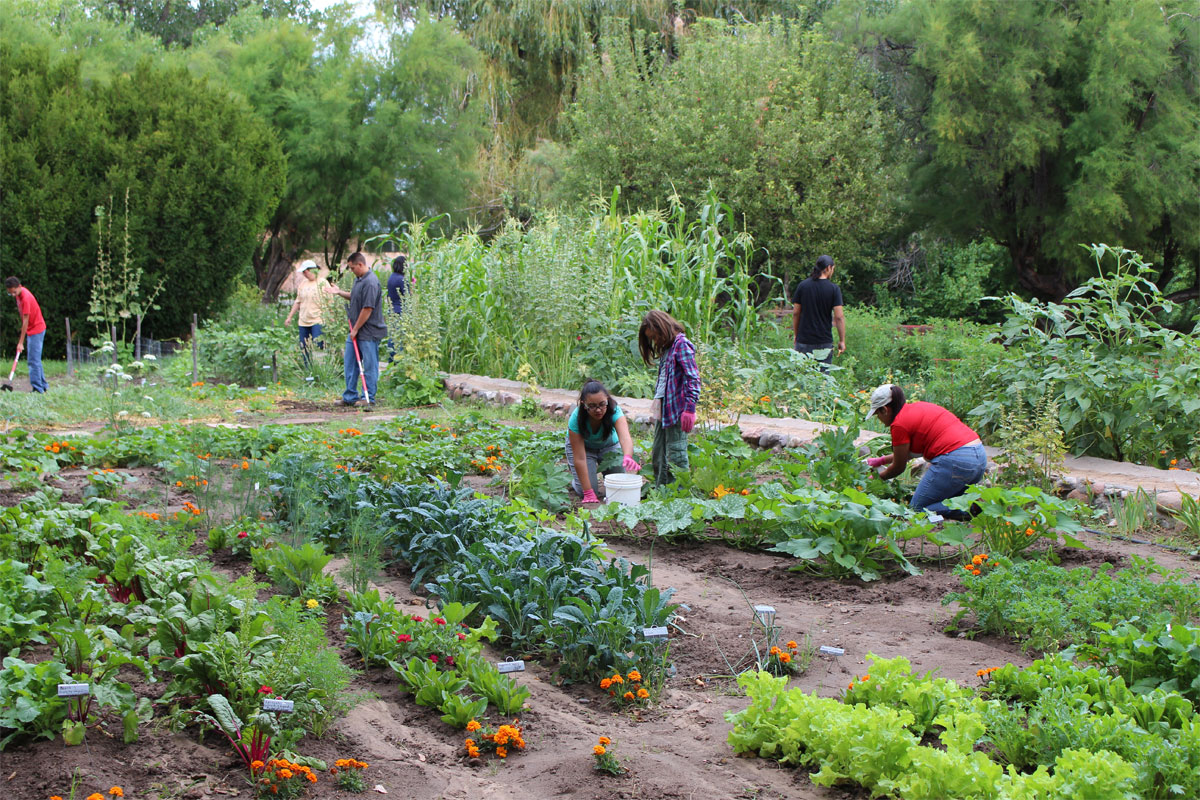April 2020
by Scott Canning, Director of Horticulture and Special Projects
My thoughts these days turn to vegetable gardening, and the revived interest I see in the ‘Victory Garden’ movements of the two World Wars means I am not alone. Seed companies cannot keep up with the demand; Johnny’s Select Seeds says “…seeds are the new toilet paper!” This is a different global crisis than a world war, but the disruptions are profound and disturbing. If you can become a bit more self-sufficient by growing some fresh food, that is empowering in itself, and will probably improve the nutritional well-being of your family, and your neighbors, too. A four-foot square of vegetable garden, a mere 16 square feet, can produce a lot of food. Experienced gardeners remember all the kale and the foot-long squashes that overwhelmed them in seasons past: Dropping them on your neighbors’ doorstep spreads that bounty around! Maybe include a zucchini bread recipe?

Students gardening in the historic vegetable garden at Georgia O’Keeffe’s home in Abiquiu.
I am not all dewy-eyed about vegetable gardening; there is both joy and frustration growing food, and it requires a bit more know-how than flower gardening. But at times of great uncertainty, there are few endeavors that are as rewarding as growing your own food from this sweet earth. As you nurture your food, it nurtures you in return. If you are new to this, it might be best to start small and expand so that you don’t get overwhelmed.
My food garden successes of late blind me, to some extent, to my early failures. I remember planting vegetable gardens into completely unimproved soil with disastrous results. And knowing how to start vegetables from seed takes skill and experience. What can I direct-sow straight into the garden? What should I try to start indoors and transplant out? And how and when do I do that? Luckily for the beginner, there are some simpler places to start, and there is the internet and other great references to ease you on your way. The Garden offers classes, and meeting and cultivating gardening friends opens a world of knowledge: I find gardeners to be very generous with their knowledge.
There are as many ways to garden as there are gardeners, but here’s a reasonably quick and inexpensive way to start with the aforementioned 16 square feet: Prepare your garden soil by turning it well with organic matter such as compost or well-rotted manure, or use the bagged materials from local nurseries in a pinch. If you skip the soil prep, go back to start! I know knowledgeable gardeners who may not till their gardens, but for amateurs, it improves the likelihood of success immensely. Visit this page.
If we confine ourselves to that 16 square-foot garden (4’ x 4’ plot) we can snake a 25’ soaker hose for good coverage. And DO use a battery-operated hose-end water timer that costs about $25; if you forget to water in New Mexico, you can lose your crop. I have found 9-volt-operated timers reliable. I have used them to back me up in my veggie gardens for many years.

Crops in the agriculture terraces of Ojos y Manos Garden.
Then start with greens and herbs, which sprout readily, and you can use the excess seedlings you “thin” from each row in salads and soups. Just sow a few feet to start, then sow more in 2-3 weeks. Sow close enough to the soaker hose so that seeds and seedlings get moistened when it runs. Have the soaker run briefly twice a day until germination. You might want to look into some floating row cover, to shade delicate greens like lettuces that otherwise ‘bolt’ to seed; and the ultra-light fabric keeps flea beetles off your arugula and other mustard-family plants. Maybe turn to the Farmers’ Market for transplantable tomatoes, peppers and eggplant after May 15th, if you have room and feel confident.
I have referred my readers to the garden blog of Margaret Roach, who over the years has compiled an invaluable resource for home gardeners. She has seed-starting calendars you can adapt to New Mexico, and she will offer a steady hand if you are a beginner. She has great advice for experienced gardeners, too.
Now here’s some advice from last April, when days were less troubled by health concerns.


